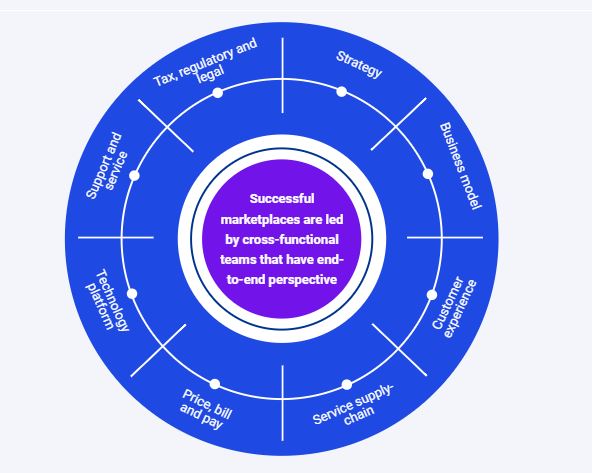B2B marketplaces: Focus areas for success
The four key foundational elements crucial for B2B marketplace success

In my recently published blogs, I explained the reasons behind the relative explosion of B2B marketplaces, and discussed the need for an enterprise-wide approach for any organization considering entering this exciting space.
For any organization wishing to take advantage of the significant opportunities, we’ve discussed the need to understand the complexities, and the importance of following the product, money, and experience.
In this final in a series of three blogs, I’ll be digging deeper into four key foundational elements I believe are crucial for those who feel ready to embark on their journey to B2B marketplace success.
1
2
3
4
Future state vision
Establish a unified vision for the future across all stakeholders that will inform the capabilities needed and the roadmap for execution:
- Formalize business targets for marketplace strategy (e.g., profitable revenue growth, share of wallet)
- Develop and align key stakeholders around a common vision for an integrated marketplace strategy
- Assess the current ecosystems and digital commerce operations to map future state capability fit/gap
- Design strategic options for the future state
Customer experience
Design the integrated marketplace B2B commerce experiences most valued by your customers, profitable for your vendors, supported by your employees, and required to realize the future state vision and business case objectives.
When addressing obstacles, finding the “sweet spot” between expectations and experience prevents loss of value:
- Economic value is lost when experience fails to meet expectations resulting in lost revenue and share
- Economic value is lost when experience significantly exceeds expectations resulting in higher than necessary operating costs
- Economic value is maximized when customer expectations and experience are in alignment
Business case and roadmap
Develop a conservative, self-funding, defensible business case for implementing a company owned marketplace as well as ongoing execution of the digital marketplace business. Common value drivers can include:
- Higher indirect revenue streams from adjacent offerings and increased top line growth from high margin products
- Reduced operational cost due to standardized catalogs, promotions, billing and fulfilment procedures across sellers
- Scalable order orchestration and fulfilment leveraging multi-vendor inventory and fulfilment capabilities
- Competitive pricing and higher quality control that keeps the sellers and buyers in check and promote healthy behavior
- Deeper insights into customer shopping behavior and buying patterns
Operating model
Define the operating model needed to enable the launch and scaling of the digital marketplace profitably. Traditional businesses typically stumble here trying to retrofit the digital marketplace business into their legacy operating model.
There are a significant number of variables to consider when deciding upon your operating model. At the center of it all is what you want your buyer experience to be at the point of purchase; what you decide upon here will have a direct effect on all the other elements of your operating model.
| Vendor experience | Payment processing | Title owner | MP Vendor |
| Inventory owner | Buyer experience at point of purchase | MP products | |
Buyer invoice generator | Fullfillment and shipping | Rebate/commission | MP services |
In addition to the above elements which are fundamental to ensuring a strong foundation for your marketplace, the following four focus areas are just as important as you look to bring your new business to fruition:
1
Have a clear business model and shared vision
It’s critical that the business model based on customer demand and regulatory compliance is driving everything. Be prepared to let go of old business practices to enable digital demands; legal should have a seat at the table but not the primary voice driving business decisions.
2
Recruit and integrate strong resources
The product owner must have executive team member support from key members, have the right talent in the right places at the right time, and align functional leads. This is not your normal platform channel so it’s easy to underestimate the impact on finance, product management, and technology.
3
Choose and manage vendors wisely
If you build it, they may not come. Vendors will heavily weigh their ROI and effort required to sell on your marketplace and manage transactions. Oftentimes, your legal requirements, business model, and contracts are a significant barrier to entry including loading catalogues, tracking products and profit, customer service, and managing refunds and returns.
4
Relentlessly track the flow of your funds
Business, legal, geography, compliance, partnerships and technology will drive the financial complexity and should be addressed up front and throughout. This includes payment methods, money transmitter licenses (MTLs), payment service providers, AP/AR reconciliation, promotions and discounts, partial orders, minimum order quantity, title, securitization, and taxes just to name a few.
An enterprise-wide perspective is crucial

Launching a B2B marketplace is complex. Getting it right requires an enterprise-wide, strategic vision and execution. Many organizations lack an understanding of the complexity involved in launching a successful marketplace – starting with the mistaken belief that a technology platform, a strong business model, and a thought-through go-to-market strategy will suffice.
Although all three of these aspects are absolutely important, they are just three of what I believe to be the eight crucial elements that need to be considered for any successful B2B marketplace.
From initial decisions on whether to enter this space, through the gathering of relevant data, to building and then sustaining a platform, marketplaces need to focus on an enterprise perspective. I’ll take a look at each of these key building blocks in turn:
Recommendations
Launching a B2B marketplace is not for the faint of heart – it is a highly complex arena which requires thorough understanding, a clear vision, and strategic planning to execute successfully. Get it right, though, and the rewards can be significant.
If you do decide that launching a B2B marketplace is for you, then I would recommend the above considerations are addressed up front, and throughout the product lifecycle.
Concentrate on these focus areas, proceed with an enterprise-wide approach, and ensure that all eight crucial marketplace elements are at front of mind throughout your journey (see blog 2 in this series for more detail), and you will give yourself the best chance of reaping the rewards.
Meet our team
